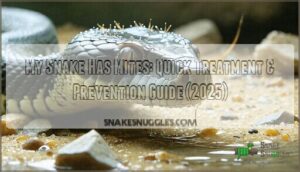This site is supported by our readers. We may earn a commission, at no cost to you, if you purchase through links.

These parasitic pests feed on blood and can seriously weaken your snake.
Start with a warm water soak to remove visible mites, then thoroughly clean and disinfect the entire enclosure.
Remove all substrate, decorations, and water dishes, and use professional-grade treatments which work best, but home remedies like diluted Betadine solutions can help temporarily.
The key is treating both your snake and their environment simultaneously – mites reproduce rapidly in substrate and hiding spots, requiring patience and multiple rounds to break the breeding cycle completely, which is crucial for successful treatment.
Table Of Contents
- Key Takeaways
- What Causes Snake Mites?
- Identifying Snake Mite Infestation
- Harmful Effects of Snake Mites
- Treating Snake Mites
- Preventing Snake Mite Infestations
- Where Do Snake Mites Come From?
- How to Avoid Snake Mite Infestations
- Frequently Asked Questions (FAQs)
- How do I get rid of mites on my snake?
- Are snake mites serious?
- Should I take my snake to the vet for mites?
- Are mites harmful to snakes?
- How to tell if your snake has mites?
- How contagious are snake mites?
- How do I know if my snake has mites?
- What should I do if my snake has mites?
- How often do I need to treat my snake for mites?
- Can I prevent snake mites?
- Conclusion
Key Takeaways
- Act fast when you spot mites – Those tiny moving specks around your snake’s eyes and heat pits indicate blood-sucking parasites that will weaken your pet through anemia and stress if left untreated.
- Treat both snake and environment simultaneously – You will need to soak your snake in warm soapy water while completely disinfecting the enclosure with a bleach solution, as mites reproduce rapidly in substrate and hiding spots.
- Expect a 3-week treatment cycle – You cannot eliminate mites with one treatment since they have a complex life cycle, so you will need weekly treatments with vet-prescribed medications like ivermectin to break their reproductive cycle completely.
- Prevention beats treatment every time – You will save yourself major headaches by quarantining new snakes for 2-3 months, maintaining strict hand hygiene between handling different reptiles, and sterilizing all substrates and decorations before use.
What Causes Snake Mites?
Snake mites typically enter your collection through new snakes, contaminated supplies, or exposure to infested environments like pet stores and reptile expos.
These tiny parasites spread quickly in captivity because your snake can’t escape like it would in the wild, creating perfect conditions for mites to multiply and establish a persistent infestation.
Mite Sources
Several sources can introduce snake mites into your reptile’s environment, making prevention essential for maintaining your pet’s health.
Common Mite Sources:
- Pet store risks – Facilities with multiple animals often harbor mites that spread between enclosures through shared equipment or airborne transmission
- Wild-caught snakes – These animals frequently carry mites from their natural habitats, requiring immediate quarantine and treatment upon acquisition
- Substrate contamination – Using untreated wood shavings, soil, or recycled materials can introduce mites hiding in organic matter
- Cross-contamination – Poor hygiene practices like handling multiple snakes without washing hands spreads mites between animals and enclosures
Contaminated items from reptile shows, borrowed equipment, and inadequate cleaning protocols create perfect conditions for mite infestations to establish and multiply rapidly.
Harmful Impacts
Your snake’s dealing with more than just annoying hitchhikers when mites move in. Blood loss from their constant feeding weakens your pet, potentially causing snake anemia over time.
These tiny wounds create perfect entry points for secondary infections, especially in less-than-pristine enclosures. Disease transmission between snakes becomes a real concern if you’re housing multiple reptiles.
The constant irritation drives up stress levels substantially, compromising your snake’s immune system. Young or already sick snakes face the highest death risk from severe infestations.
These snake mites harmful effects compound quickly, making prompt treatment essential for your pet’s wellbeing. Infestations often stem from poor hygiene practices and contaminated environments.
Elimination Methods
Once you’ve spotted those tiny blood-sucking invaders, swift action prevents further damage. Effective snake mites treatment requires a multi-pronged approach combining veterinary-prescribed medications with thorough environmental management.
Treatment Duration typically spans 2-4 weeks, requiring patience and persistence. Ivermectin from your vet offers the most reliable results, while snake mite insecticides like Provent-A-Mite target lingering populations.
Quarantine Protocols demand isolating affected snakes immediately. Miticides Compared: Prescription treatments outperform over-the-counter options substantially. Natural Remedies: Gentle dish soap soaks can drown visible mites effectively.
- Snake mite treatment methods: Combine medication, cleaning, and environmental spraying. Resistance Issues: Rotate treatments to prevent mite adaptation. Mite treatment: Repeat applications break the reproductive cycle completely.
Identifying Snake Mite Infestation
Now that you know what causes these pesky parasites, let’s focus on spotting them before they become a bigger problem. Early detection makes all the difference in protecting your snake’s health.
Recognizing snake mites identification requires careful observation of both your snake and its environment. These tiny bloodsuckers leave clear signs when you know what to look for:
- Mite Visibility: Tiny moving black, red, or brown specks on your snake’s skin, especially around eyes and ears
- Behavior Changes: Excessive rubbing against objects, prolonged soaking, lethargy, or reduced appetite indicating discomfort
- Scale Examination: Black dots clustered near thin-skinned areas like the vent, plus ashy residue on scales
- Anemia Signs: Pale gums or mouth lining from blood loss, particularly in severe infestations
- Unusual Shedding: Mites may appear on shed skin or transfer to your hands after handling
To confirm, use the white paper test to spot mites.
Harmful Effects of Snake Mites
Looking at snake mite harm isn’t just about tiny bugs—it’s about understanding serious health consequences that develop gradually. Snake mites create multiple dangerous pathways for illness in your reptile.
Blood loss from continuous feeding leads to anemia risk, weakening your snake’s immune system and overall well-being. The microscopic wounds these parasites create become infection gateways, particularly problematic in less-than-pristine environments.
Disease transmission represents another significant concern, as mites carry pathogens between hosts. Your snake’s stress levels spike from constant irritation and discomfort, compromising natural behaviors and appetite.
Extended infestations cause scale damage through excessive rubbing and scratching behaviors. Snake mite blood loss accumulates over time, creating nutritional deficits that affect growth and healing.
Respiratory issues can develop in severe cases, while snake mite dangers multiply when multiple animals share spaces. One key indicator is excessive soaking behavior, as snakes attempt to alleviate skin irritation.
Young or immunocompromised snakes face the highest snake mite risks, potentially leading to life-threatening complications if snake mite harm goes untreated for extended periods.
Treating Snake Mites
When you discover mites on your snake, quick action prevents the infestation from worsening and spreading to other reptiles.
Treatment involves multiple steps including veterinary-approved medications, thorough enclosure cleaning, and careful monitoring to break the mite life cycle completely, which is crucial for the health of your snake, and this process requires quick action to be effective.
Veterinary Consultation
Consulting your veterinarian promptly guarantees proper medication options and severity assessment for your snake’s mite infestation.
A reptile vet will conduct diagnostic tests, prescribe treatments like ivermectin or pyrethroids, and establish follow-up care protocols to monitor your snake’s recovery from potential anemia.
- Peace of mind: Professional veterinary consultation eliminates guesswork during this stressful situation
- Your snake’s survival: Expert anemia treatment can literally save your pet’s life
Safe Insecticides
Several reptile-safe options effectively eliminate snake mites when applied correctly. Permethrin-based products like Nix (diluted 1:68 with water) or chicken dust containing 0.25% permethrin offer excellent results.
Natural Chemistry Reptile Mite Sprays use dioctyl sodium sulfosuccinate, providing safer alternatives for sensitive snakes. Always follow dosage guidelines precisely—overdosing compromises safety while underdosing creates resistance concerns.
It’s also important to note that permethrin dust is cost-effective and lasts longer than sprays, making it a cost-effective option with a longer duration than sprays.
Enclosure Cleaning
Everyone knows cleaning your snake enclosure thoroughly is essential for eliminating mites and their eggs. Start by removing everything from the reptile enclosure, then scrub surfaces with hot water exceeding 122°F and a 3% bleach solution.
Mites are strongly attracted to reptile scent, so it’s important to eliminate all traces of it during cleaning, which is why mite spread can happen quickly.
- Disinfectant Choices: Use F10 or bleach solutions for effective mite elimination
- Substrate Selection: Replace all bedding with disposable paper towels temporarily
- Cleaning Frequency: Deep clean weekly during treatment to break mite lifecycles
- Safe Products: Rinse thoroughly after chemical cleaning before reintroducing your snake
Hot Water Soak
A hot water soak effectively drowns mites clinging to your snake’s scales. Fill a secure container with warm water between 75-85°F – never exceed this soak temperature to prevent burns.
Add a drop of mild dish soap as soap additives help break surface tension. A proper snake soak container is essential for safety.
Maintain soak duration of 20-30 minutes while supervising for snake safety. After soaking, gently blot your snake dry for proper post-soak care.
Repeat Treatment
Mite infestations require persistence – you can’t win this battle with a single treatment.
Repeat your snake mite treatment weekly for three weeks to break their reproductive cycle and prevent reinfestation. This timing disrupts cycle disruption effectively, stopping resistance building before mites adapt.
Follow this long-term monitoring schedule:
- Week 1: Complete enclosure cleaning, snake treatment, and fipronil application
- Week 2: Repeat all treatments to target newly hatched mites
- Week 3: Final treatment round guarantees complete elimination
This snake mite long process prevents reinfestation by targeting all life stages.
Preventing Snake Mite Infestations
After successfully treating your snake’s mite infestation, establishing robust snake mite prevention measures becomes your next priority.
Prevention isn’t just about keeping mites away—it’s about creating a fortress of protection around your entire collection.
| Prevention Strategy | Implementation | Timeline |
|---|---|---|
| Quarantine Protocols | Isolate new reptiles in separate room with paper substrate | 2-3 months minimum |
| Hygiene Importance | Wash hands between handling, disinfect tools weekly | Daily/weekly routine |
| Substrate Selection | Bake new substrate at 200°F or freeze for 48 hours | Before each use |
| Routine Inspections | Check for mite feces, behavioral changes, physical signs | Weekly examinations |
Snake mite quarantine isn’t negotiable—treat every new arrival as potentially infested regardless of reputable sources.
Snake mite introduction prevention requires maintaining separate equipment for each enclosure and conducting flashlight inspections focusing on gular folds.
Remember, mite prevention works best when you’re consistently vigilant rather than reactive.
Where Do Snake Mites Come From?
Understanding where snake mites originate helps you prevent future infestations in your reptile collection.
These microscopic parasites don’t appear randomly—they have specific sources that responsible snake owners can identify and avoid.
Here are the four primary sources of snake mite infestations:
- Wild-caught snakes – Freshly captured reptiles often carry mites from their natural habitat, making quarantine essential before introducing them to your collection.
- Pet stores and snake breeding facilities – High-density environments with multiple animals create perfect conditions for cross-contamination between enclosures.
- Contaminated substrate – Bedding materials, especially natural products like bark or wood chips, can harbor mite eggs that hatch after you’ve introduced them to your snake’s enclosure.
- Poor hygiene practices – Handling multiple snakes without washing hands between animals allows mites to spread rapidly through your entire collection.
How to Avoid Snake Mite Infestations
Preventing snake mites requires five essential strategies that’ll keep your reptilian companion healthy and comfortable.
These tiny parasites spread quickly, but proper prevention makes all the difference in maintaining a thriving snake environment.
Quarantine Protocols: Isolate new snakes for 2-3 months in separate enclosures before introducing them to your collection.
This snake quarantine period allows you to identify potential snake mite sources before they spread.
Hand Hygiene: Wash your hands thoroughly before and after handling each snake.
This simple practice prevents cross-contamination between enclosures and reduces snake mites causes substantially.
Supply Sterilization: Purchase substrates and decorations from reputable sources only.
Sterilize all new items with bleach solution before adding them to enclosures, as contaminated supplies are common snake mite sources.
Conduct routine inspections weekly, examining your snake’s skin for tiny moving specks, especially around the eyes and ears.
Understanding the mite’s life cycle is vital for effective prevention.
Effective snake mites prevention starts with vigilant monitoring and maintaining impeccable enclosure cleanliness throughout your reptile’s life.
Frequently Asked Questions (FAQs)
How do I get rid of mites on my snake?
Those pesky parasites are a nightmare!
Quarantine your snake immediately, soak in gentle dish soap solution.
Apply vet-prescribed ivermectin, thoroughly disinfect the enclosure with bleach.
Repeat treatments weekly for three weeks.
Are snake mites serious?
Yes, snake mites are serious. They cause blood loss leading to anemia, transmit diseases between snakes, create infected wounds, and weaken your snake’s immune system. Untreated infestations can be fatal.
Should I take my snake to the vet for mites?
While mites aren’t immediately life-threatening, they’re like tiny vampires that’ll weaken your snake through blood loss and stress.
A vet can prescribe effective treatments like ivermectin and guide proper eradication protocols.
Are mites harmful to snakes?
Mites are harmful to snakes, causing blood loss, anemia, and weakened immunity.
They transmit diseases between reptiles and create infected wounds from scratching.
Severe infestations can lead to death if untreated.
How to tell if your snake has mites?
Like tiny hitchhikers on a cross-country journey, mites appear as small moving dots resembling black pepper flakes crawling across your snake’s skin, especially around the eyes, ears, and mouth where skin’s thinnest.
How contagious are snake mites?
Snake mites spread extremely easily between reptiles through direct contact, contaminated hands, shared equipment, and infested environments.
They’re highly contagious and can rapidly infest your entire collection if proper quarantine isn’t maintained.
How do I know if my snake has mites?
Mites double their population every few days under ideal conditions, making early detection essential.
You’ll spot tiny black, red, or brown moving specks on your snake’s skin, especially around the eyes and ears.
Watch for increased rubbing behavior and check your hands after handling, as this can help in detection.
What should I do if my snake has mites?
Immediately quarantine your snake in a sterile enclosure, then consult a veterinarian for prescription treatments like ivermectin. Clean the original habitat thoroughly with bleach solution and repeat treatments weekly.
How often do I need to treat my snake for mites?
Persistence beats persistence—you’ll need weekly treatments for three weeks minimum to break the mite life cycle. Treat both snake and enclosure repeatedly, as eggs hatch after initial treatment.
Can I prevent snake mites?
Yes, you can prevent snake mites through proper quarantine, hygiene, and habitat management.
Quarantine new snakes for 2-3 months.
Maintain clean enclosures, wash hands between handling, and avoid contaminated sources like unreliable dealers.
Conclusion
Successfully treating snake mites requires dedication, persistence, and systematic elimination. You’ll battle these bloodsucking parasites through multiple treatment cycles, thorough enclosure sterilization, and careful monitoring.
When my snake has mites, immediate action prevents serious health complications and rapid population explosion.
Professional veterinary treatments prove most effective, though temporary home remedies provide initial relief.
Prevention through quarantine protocols and regular health checks remains your strongest defense against future infestations.
With proper treatment and environmental management, you’ll eliminate mites completely and restore your snake’s peak health.
- https://herpetocultureinc.com/2024/01/25/the-easy-fast-and-effective-way-to-treat-snake-mites/
- https://www.cornsnakes.com/forums/threads/mites.127506/
- https://www.ssnakess.com/forums/showthread.php?t=17014
- https://bngmiraclepet.com/products/reptile-spray
- https://community.morphmarket.com/t/mites-i-need-help/14656















